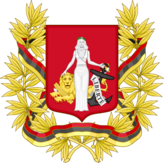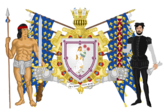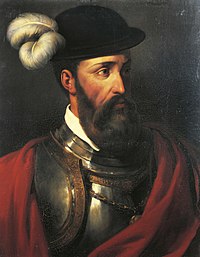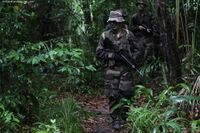Gaullica-Satucin relations
This article is incomplete because it is pending further input from participants, or it is a work-in-progress by one author. Please comment on this article's talk page to share your input, comments and questions. Note: To contribute to this article, you may need to seek help from the author(s) of this page. |
 | |
Gaullica |
Satucin |
|---|---|
| Diplomatic mission | |
| Gaullican Embassy, Gatôn | Satucinais Embassy, Verlois |
| Envoy | |
| Ambassador Abraham Calvet | Ambassador Estelle Favre |
Gaullica-Satucin relations (Gaullican: Relations entre la République gaulloise et l'Union des Satucins) are the bilateral relations between the Republic of Gaullica and the Union of Satucin. The history of both countries began with the declaration by Pierre Avenard of his claiming of the land of the Sythes river basin for the Gaullican Empire in June of 1539.
Relations between the natives and the Gaullican crown were largely up to the governing of the six established viceroyalties, and the relations between themselves and the crown were as equally as varied and subject to change throughout the centuries. Relations were tumultuous during the period in which the Gaullicans aimed at outlawing slavery in their colonies, and were only resolved by the colonial unification of Satucin in 1846.
From unification until the end of the Great War, Satucin was one of two Dominions in the Gaullican Empire (the other being Cassier) and was granted independence from Gaullica at the conclusion of the war. Since independence, Gaullica and Satucin have had a healthy relationship based on their historic, cultural and linguistic ties.
Country comparison
| Flag | 
| |
| Coat of Arms | 
|

|
| Anthem | Chant des Gaullois | Allons Armée Catholique |
| Capital city | Verlois | Gatôn |
| Largest city | Verlois – 8,781,017 | Gatôn – 10,340,927 |
| Established | September 6, 1936 | April 5 1939 |
| Government | Federal semi-presidential republic | Federal constitutional monarchy |
| First leader | Albert Montecardé | Cyrile Montecardé |
| Current leader | Monique Degar-Abdulrashid | Théodore I |
| Main language | Gaullican | Gaullican |
| Main religions | 88.1% Solarian Catholic 2.8% No religion 2.2% Other Sotirian 1.3% Atudite 1.3% Irfan 4.3% Other |
68.4% Solarian Catholic 1.3% No religion 23.2% Other Sotirian 0.3% Atudite 0.8% Irfan 6.3% Other |
| Area | 786,321 km2 (303,600 sq mi) | 3,022,226 km2 (1,166,888 sq mi) |
| Population | 87,176,289 | 201,105,368 |
| Population density | 110/km2 (284.9/mi2) | 75/km2 (194.2/mi2) |
| GDP (nominal) | $3.377 trillion | $1.690 trillion |
| GDP (nominal) per capita | $38,738 | $13,514 |
| GDP (PPP) | $4.221 trillion | $2.683 trillion |
| GDP (PPP) per capita | $46,485 | $21,451 |
Historical relations
Colonial Era (1539 - 1846)

In late 1537 Pierre Avenard began his venture from Maredoux to Port de la Sainte on the Arucian island of Sainte-Chloé, taking with him six ships. He arrived by mid 1538, where he spent much of the time at port retaining supplies and undergoing numerous ventures and explorations across the Arucian. By April of 1539, Avenard began launching expeditions along the coast of Asteria Inferior. He left one ship to set up the fort known as La Porte on the westernmost island of Parane, where it still stands today, and began sailing in a southwards direction.
Arriving at the Sythes river basin on the 24th of June, Avenard and his men disembarked from their ships by way of rowboats towards the banks of the Sythes and upon landing declared the land property of the Emperor in Verlois. With further supplies arriving by way of Sainte-Chloé, settlement of the coast of Satucin began in earnest by the proclamation of Francois I, dividing the newly charted land into six viceroyalties. The territory however was vast, unexplored and unclaimed at this point with only one viceroy, Avenard being declared the Viceroy of Pasau with this declaration.
The Gaullicans would encounter various indigenous peoples who likely spoke related Marai languages, especially as they began to venture up the coast and up the Sythes river. Relations between the Gaullicans and the natives varied tremendously on the indigenous group involved: some were retained as guides and trade was established between them. However several native peoples were sent back to the Arucian colonies as slaves following skirmishes on the river and across the new settlements. Others still were wiped out by both disease and force of arms in the clearing of coastal areas for Euclean settlement.
What would become Satucin became a legend in Gaullica and in Euclea; the reports from Avenard's expedition spoke of an "immense wilderness and countless creatures never before seen." Indeed, Avenard's accounts are the first Euclean records of: jaguars, piranha, sloths and what he described as 'magic frogs that kill by touch'.
Avenard's exploits, discoveries and rumours -- including that of a legendary city of silver that the Sythes flowed through -- caught the attention of other Euclean powers and explorers. Gaullcia became embroiled in an economic competition with other maritime powers, wrestling for control and colonial of the Satucine coast for much of the remainder of the 16th and early 17th century.
Whilst Gaullica initially settled the coast of Satucin and launched expeditions to the interior unopposed, and possessed a monopoly on its exotic wood and new crops, it would not be long for other Euclean maritime powers to aim to break Gaullica's monopoly. In 1561, a Caldian expedition financed by Cassair Mac Cana, Count of Clane landed at the tip of the Anniane Peninsula. There, the Caldish settled a colony and outpost that brought contention to the region. The Gaullicans had initially objected to settling at the tip of the peninsula, given its rugged terrain and belief that control of the straits could be maintained from La Porte. However, Caldian naval presence brought about fears of control from the straits of Parane. By 1570, armed colonists and Gaullican naval efforts in the region had driven the Caldish colonists out.
For Gaullica however, the Caldish represented the first of the Euclean attempts -- and were succeeded in the region by numerous settlements established by Poveglian merchants and explorers. At the time, Gaullica and Poveglia were diplomatically allied -- the Gaullican empire had often attempted to intervene in Vespasian affairs through its city-state ally, but when it came to the establishment of colonies contention grew. In 1588, a Vespasian fleet blockaded the port of Sainte-Chloé and two fleets exchanged fire near the straits of Parane. Gaullican forces took two Poveglian coastal outposts settled in modern day Nouveau Sessonis, as well as all territories established west of the straits, but the Poveglian fleets had destroyed the Imperial colonies set up along the coasts of modern day Adamantina and Gapolania.
By 1601, Gaullican and Poveglian diplomats created a formal agreement on the separation of interests in the region. This agreement established that Gaullican interest would extend over the northern coast of the territory of its established six-viceroyalties, as well as the islands of the Straits of Parane, but would not extend further along the northern coast of Asteria Inferior. The Manouida Mountains were chosen as the natural border between both colonies. In addition, Gaullica granted the Poveglians free travel through the straits in an exchange for the recognition of Gaullica's claims to the Îles Émeraude. Both parties agreed on a mutual defence agreement from competing Euclean powers in the region; and Gaullica accepted the Poveglian claim to the northern coast of the straits of Parane. Despite its vague wording on the particular extent at where the six viceroyalties of Satucin ended; it did give shape to the border regions between the Gaullican and Poveglian colonies.
The denouncement of the enslavement of native peoples, as well as their initial susceptibility to old world diseases, led the viceroyalties to demand a further increase in the Bahian slave trade. Several of the viceroys were involved in supporting the establishment of Michel Masson's Lower Gonda Company and its successful settlement of Sainte-Germaine, which oversaw the shipment of over 2,000,000 enslaved peoples to the Asterian colonies. The vast expanse of the colony, its ideal temperature for growing certain crops, the discovery of precious metals and the expansive lumber-networks resulted in an atypical Gaullican colony. Whilst Cassier was a settler colony, for instance, the Satucinais Viceroyalties were a mixture of both settler and slave colonies. It is estimated that by 1700 the enslaved population was twice as large as the free and was growing at a faster rate.
With little oversight in way of their internal relationships from home, the competitive nature of the viceroyalties reached numerous critical stages. The monopoly of the port of Anneville in Annianne saw an explosion of economic and population growth that the other viceroyalties failed to replicate, even those that had been established earlier.
This, as well as the status of slavery in the wider Gaullican Empire during the 19th century, would lead to the thirty-four year long Satucine Civil Wars, which would end in the six viceroyalties being united under self-government as the Dominion of Satucin.
The Dominion of Satucin (1846 - 1935)
Post-independence (1936 - )
Culture
Film
Initially, motion picture media consumed in Satucin was directly influenced, maintained and produced by Gaullica's domestic film industry. One of the first in the world, its export to the dominions and colonies set about the creation of a network of closely linked film studios that often produced works of similar styles. By 1907, there were six major production centres across the Gaullican Empire for its expansive film industry -- the second largest was in Gatôn.
Film screenings across the Empire were often exclusively northern productions; often silent films that were domestically produced in Gaullica that were exported. Gatôn's film studio, however, produced several pieces of its own work and cemented itself as an important fixture of the Gaullophone's film industry. However, by the 1920s, the creative liberties afforded to these studios were increasingly threatened by both the Functionalist Gaullican government and Satucin's Parti d'Action led by Henri Masson. In both cases, the film studio was monopolised into producing pieces of propaganda for domestic consumption and for the war effort.
With the fragment of the empire, the expansive network of film studios found themselves well-established to begin operation of their own domestic productions and this led to an initial preventative measure of an importation quota in Gaullica. However, by the mid-1950s, these proved unpopular.
Gaullican films continue to prove popular in Satucin; and many of the styles and art forms that evolved out of Gaullica gained immense popularity in Satucin. The inverse is also true, most known for Satucin's "New Cinema", which itself was influenced by the dramatic Gaullican Neorealism and Existentialist movements.
Satucine directors and actors find themselves easy to adapt in Gaullica and vice-versa, and increasingly the styles of Satucine films are growing increasingly popular in Gaullica's own domestic markets.
Literature
Gaullican literature, both historic and contemporary, is popular in much of the former empire; Satucin included. Historically; the Satucine education system often prioritised Gaullican literature in its curriculum: novels, plays, poems and essays were almost exclusively from Gaullican authors. In more recent times, however, Satucin has begun a gradual shift towards a promotion and celebration of its domestic literature scenes.
In Gaullica it is possible in many centres of higher education to partake in classes pertaining to international Gaullican literature; Satucine works included.
As a subject, Satucin has represented much in Gaullican literature circles. It often enjoyed a sense of wonderment, what was referred to at the time as "untamed, virgin land -- ripe for adventure and exploration". As a theme it often coincided with a belief in liberty, freedom from government and a place to live ones destiny to themselves. In more recent times it represents a familiar, yet exotic, location for the Gaullican reader.
Due to promotions put forward between both governments, and the Association of Gaullophone States, Satucine literature has gained a foothold in Gaullica.
Music
Like in all other forms of culture, Gaullica and the countries established by its settlers share a substantial amount of their culture. Gaullican high culture, particularly in preferences in music, was mirrored in its colonies. What was 'done in Verlois', was mirrored in Gatôn. When it comes to music however, Satucinais developments in the international music scene in the late 19th and 20th century would greatly influence Gaullican music and that of the wider empire.
Satucin, the largest of Gaullica's Asterian colonies, was poised as a cultural crossroads between its white Euclean settlers, the imported Bahian slaves and Coian Gowsas and the remnants of the native peoples who inhabited it. Many of these musical traditions evolved into what is now known as jazz. Gatôn's style of jazz club was quickly imported into Verlois, where it was exported across the empire; to Sainte-Germaine and Jindao in particular, before growing a particular cult-following amongst the liberal middle-class of Werania.
Furthermore, the subcultures of the Bahian-Satucinais produced local music, such as Kasékò, that has become a mainstay of modern day Satucinais Pop and alternative music.
Economic cooperation
Trade
Satucin is Gaullica's leading trade partner in the Asterias and one of its most important trade partners outside of the Euclean Community. In 2020, the total value of trade between Gaullica and Satucin was valued at '€x'. Gaullica's main exports to Satucin were listed as: electronic equipment, pharmaceutical products and vehicles. Satucin's main exports to Gaullica were listed as: agricultural products like coffee, tea and spices, wood and articles of wood and animal fodder.
Military cooperation
Sharing close geographical proximity to one another because of the Îles des Saintes, Gaullica and Satucin regularly conduct joint-naval exercises in the Eastern Arucian region. Two forms of exercises currently exist and take place on alternative years. The earliest established 'Saint-Thomas Exercises' are held between Gaullica and Satucin and form an important part of bilateral relations. These war-games focus on prioritising coordination on capabilities like cross-deck operations, anti-submarine warfare and information sharing among others. Originally beginning in the late 1970s, as Gaullica's naval capabilities continued to grow, they have remained a key cornerstone of diplomatic relations between both countries.
The second are the 'Arucian Emergency Exercises', jointly held by Gaullica and Satucin every other year with much of the Arucian in attendance. This cooperation focuses on humanitarian aid, human evacuation in the wake of simulated natural disasters and aid deployment.
Gaullican and Satucine naval forces have also cooperated in recent events. In the wake of the a Chistovodian seizure of a Satucine freighter in July of 2019, the Gaullican vessels stationed at the Îles des Saintes were quick to mobilise to Satucin's support. Similarly, during the aftermath of the 2020 eruption of Pico de Sangue Gaullican and Satucine cooperation in humanitarian disaster training was utilised to assist the island.
Territorially, the special forces of both countries sometimes cooperate in war-games. Often times these simulated war-games take place in locations across Satucin and Gaullica's Arucian islands, but have also been held in mainland Gaullica and Nouvel Anglet before. They prioritise crisis-action planning, simulated scenarios of situations such as piracy, smuggling, human-trafficking and hostage rescue, and hostile environment training in locations such as the Satucine rainforests.
Resident diplomatic missions
Gaullican missions in Satucin
- Gatôn (embassy)
- Pasau (consulate-general)
- Satau (consulate-general)
- Bonhavre (consulate)
Satucinais missions in Gaullica
- Verlois (embassy)
- Rayenne (consulate-general)
- Saint-Thomas (consulate)


